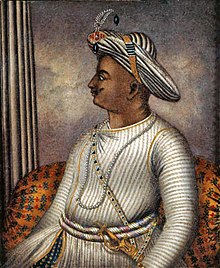Masjid Zeenath Baksh
| Masjid Zeenath Baksh | |
|---|---|
Baliye Palli | |
Malik Deenar | |
| Date established | April 18, 643 AD (Approx.) |
The Zeenath Baksh Juma Masjid ('Mosque that reflects beauty') commonly known as Masjid Zeenath Baksh is the 3rd oldest mosque in India and the oldest in the state of Karnataka constructed during 644 AD. This masjid which is also known as Beliye Palli is located in the Bunder area in the city of Mangalore and is well known for its pure Indian architecture style.
The mosque was established by the kin and kith of
History
Arab traders have had a warm longstanding relationship with the local population as well as the rulers of the western coastal belt of India from the earliest of the times, and have engaged in trade through the Arabian Sea.[1]

Consequent on the advent of Islam in the early stage, a team of Arab Muslim Traders, under the Leadership of Islamic propagator
Masjid Zeenath Baksh was the second out of the ten mosques built by them following Cheraman Juma Mosque of Kodungallur . The masjid was inaugurated on Friday the 22nd of the month of Jumada al-awwal, hijra 22 (approx. April 18, 643 AD), with Malik Bin Abdullah being appointed as the first Khazi.[4][5]
In the later half of the 18th century, Tipu Sultan, the sultan of Mysore undertook the renovation process of the mosque.[6] The mosque was not only renovated but also beautified with exquisite wooden carving. These rare pieces of artwork adorn the pillars and ceiling of the mosque.[7][1] It was also during this time that the mosque was renamed "Zeenath Baksh Jama Masjid" from "Malik Dinar Valya Juma-ath Masjid" by Tipu sultan after his daughter.[1]
Features
Although a mosque, Zeenath Baksh has characteristics similar to that of the many temples found in the region, most notably the temple tank similar to those in traditional Hindu temples is found within the proximity of the mosque.[6]
Zeenath Baksh is the only mosque in the state of Karnataka made entirely of wood. The main highlight of the mosque is the wooden inner sanctum consisting of 16 pillars made of teak. The structure is adorned with patterns of symbols, bells, and flowers. It also has life stories of Muhammad inscribed in it. This wooden structure is made up of teak and rosewood which has been used to construct the floor, ceiling, walls and the doors.[7][1]
Gallery
-
The water tank within the mosque premises
-
The exquisite wood carvings in the pillars of the mosque
See also
- Cheraman Juma Mosque of Kodungallur
- Tipu Sultan
- Kali Masjid, Jalna
- Malik Deenar
- Jan-ul-lah Shah Muhammad
- Jama Masjid
References
- ^ a b c d e "Zeenath Baksh Masjid | Zeenath Baksh Masjid Mangalore | Zeenath Baksh Masjid History". Karnataka.com. 2 December 2017. Retrieved 30 June 2018.
- ^ "Zeenath Baksh Masjid, Indian Masjid Zeenath Baksh, Karnataka Masjid Zeenath Baksh, Masjid Zeenath Baksh travel guide, The Zeenath Baksh Masjid of Mangalore". www.kamalkapoor.com. Retrieved 20 May 2018.
- ^ "Masjid Zeenath Baksh (Jumma Masjid), Mangalore - tourmet". tourmet. 6 January 2015. Retrieved 20 May 2018.
- ^ Mangalore, Mangalore Today. "Historic Masjids of Mangalore". www.mangaloretoday.com. Retrieved 30 June 2018.
- ^ "Hijri Gregorian Converter by IslamiCity.org - Most Beautiful Hijri Converter on the Web - IslamiCity". www.islamicity.org. Retrieved 12 April 2021.
- ^ a b "Zeenath Baksh Mosque, Zeenath Baksh Juma Masjid Mangalore". www.mangaluruonline.in. Retrieved 20 May 2018.
- ^ ISSN 0971-751X. Retrieved 20 May 2018.


